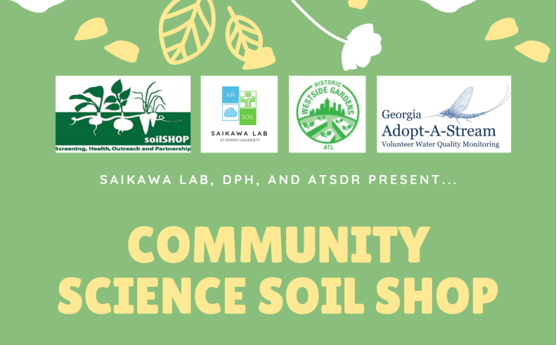
by Chelsea Thomas, Atlanta Botanical Gardens
FREE soil and compost testing!
Participate by Nov 15!
Where: Atlanta Botanical Gardens (ABG) – a labeled collection bin in front of the ABG gift shop. (Also possible by mail or other drop box locations.)
Why: To determine the extent and distribution of possible lead contamination in the greater Atlanta area.
Explanation:
Back in June, I heard Dr. Eri Saikawa of Emory give a virtual talk for Science for Georgia about soil contamination. She explained that the full extent or distribution of lead and other heavy metal contamination in this area is not fully understood. Learning more could help make sure all local food systems remain safe for everyone. I suggested perhaps we could design a citizen science project and call on larger networks like ABG to get access to more samples of both soil and compost. So the unstoppable Dr. Saikawa set it up and found the funding to make this event free for anyone who’d like to participate!
The ever-inspiring Moe Hemmings took this on in addition to all her other amazing projects and arranged for ABG to be a drop-off location for the samples. The brilliant Annie Martin is making custom signage for us, so on the collection dates you’ll find a clearly labelled, locked collection bin out to the left of the main entrance, right of the information booth, i.e. in front of the gift shop.
We’re interested in soil or compost from any garden, playground, or backyard. It does NOT have to be inside the Atlanta Perimeter! I imagine other people can bring soil, so I’m particularly hoping our community can help bring in some compost samples too. Metals have been found in some compost samples before, which makes sense given the Saikawa Lab’s research into “phytoremediation“, the use of certain plants to remove heavy metal pollution. It turns out some plants are really good at pulling up metals from the soil around them. This could be a problem if they are composted and result in a higher concentration than the original soil, but it can also be a cool solution if we learn to use them to safely remove the contaminants!
If you’d like to participate, you’ll follow the video & instructions from the website to collect your sample, label it to match the online submission form, and drop your sample into the bin. At the end of each day, I’ll collect the samples and bring them straight to Dr. Saikawa’s lab. (Alternately, you can mail your samples rather than bringing them into ABG).
Each person can contribute up to two samples. It’s free for everyone. Because we’re not sure how many samples she’ll get, we don’t know how soon you’ll get the results, but they will be communicated back to you by the email on the submission form.
Get Involved!
https://atlsoilsafety.com/community-science-soilshop/ Here’s the project website. A few more adjustments are coming, but it’s up and running now.
Learn More!
Also, https://atlsoilsafety.com/ this is Dr. Saikawa’s lab, in case you want to learn more about soil contamination in general.
